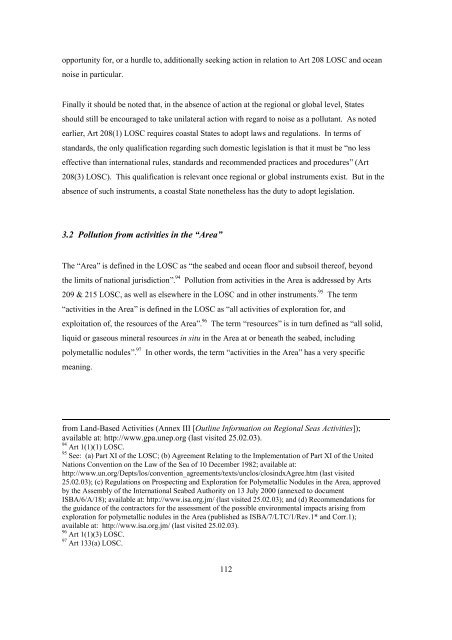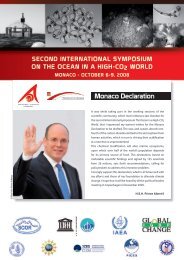Oceans of noise - Whale and Dolphin Conservation Society
Oceans of noise - Whale and Dolphin Conservation Society
Oceans of noise - Whale and Dolphin Conservation Society
- No tags were found...
Create successful ePaper yourself
Turn your PDF publications into a flip-book with our unique Google optimized e-Paper software.
opportunity for, or a hurdle to, additionally seeking action in relation to Art 208 LOSC <strong>and</strong> ocean<strong>noise</strong> in particular.Finally it should be noted that, in the absence <strong>of</strong> action at the regional or global level, Statesshould still be encouraged to take unilateral action with regard to <strong>noise</strong> as a pollutant. As notedearlier, Art 208(1) LOSC requires coastal States to adopt laws <strong>and</strong> regulations. In terms <strong>of</strong>st<strong>and</strong>ards, the only qualification regarding such domestic legislation is that it must be “no lesseffective than international rules, st<strong>and</strong>ards <strong>and</strong> recommended practices <strong>and</strong> procedures” (Art208(3) LOSC). This qualification is relevant once regional or global instruments exist. But in theabsence <strong>of</strong> such instruments, a coastal State nonetheless has the duty to adopt legislation.3.2 Pollution from activities in the “Area”The “Area” is defined in the LOSC as “the seabed <strong>and</strong> ocean floor <strong>and</strong> subsoil there<strong>of</strong>, beyondthe limits <strong>of</strong> national jurisdiction”. 94 Pollution from activities in the Area is addressed by Arts209 & 215 LOSC, as well as elsewhere in the LOSC <strong>and</strong> in other instruments. 95 The term“activities in the Area” is defined in the LOSC as “all activities <strong>of</strong> exploration for, <strong>and</strong>exploitation <strong>of</strong>, the resources <strong>of</strong> the Area”. 96 The term “resources” is in turn defined as “all solid,liquid or gaseous mineral resources in situ in the Area at or beneath the seabed, includingpolymetallic nodules”. 97 In other words, the term “activities in the Area” has a very specificmeaning.from L<strong>and</strong>-Based Activities (Annex III [Outline Information on Regional Seas Activities]);available at: http://www.gpa.unep.org (last visited 25.02.03).94 Art 1(1)(1) LOSC.95 See: (a) Part XI <strong>of</strong> the LOSC; (b) Agreement Relating to the Implementation <strong>of</strong> Part XI <strong>of</strong> the UnitedNations Convention on the Law <strong>of</strong> the Sea <strong>of</strong> 10 December 1982; available at:http://www.un.org/Depts/los/convention_agreements/texts/unclos/closindxAgree.htm (last visited25.02.03); (c) Regulations on Prospecting <strong>and</strong> Exploration for Polymetallic Nodules in the Area, approvedby the Assembly <strong>of</strong> the International Seabed Authority on 13 July 2000 (annexed to documentISBA/6/A/18); available at: http://www.isa.org.jm/ (last visited 25.02.03); <strong>and</strong> (d) Recommendations forthe guidance <strong>of</strong> the contractors for the assessment <strong>of</strong> the possible environmental impacts arising fromexploration for polymetallic nodules in the Area (published as ISBA/7/LTC/1/Rev.1* <strong>and</strong> Corr.1);available at: http://www.isa.org.jm/ (last visited 25.02.03).96 Art 1(1)(3) LOSC.97 Art 133(a) LOSC.112




